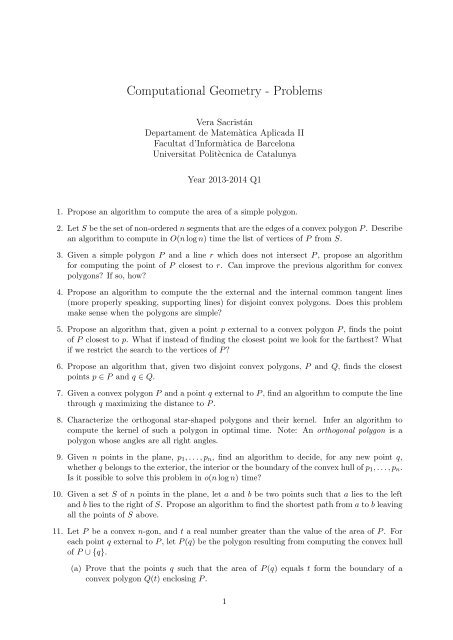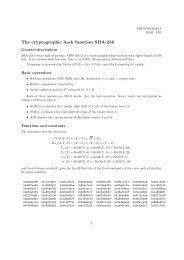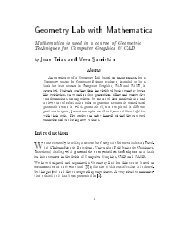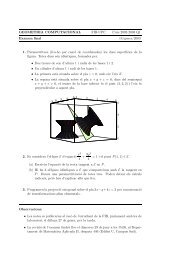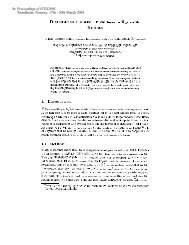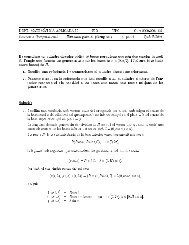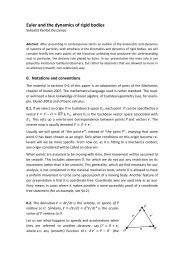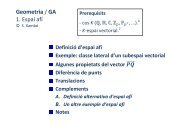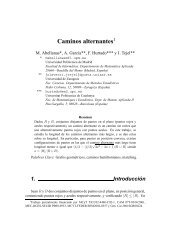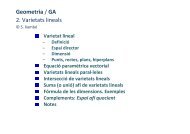Problems - Departament de Matemàtica Aplicada II
Problems - Departament de Matemàtica Aplicada II
Problems - Departament de Matemàtica Aplicada II
Create successful ePaper yourself
Turn your PDF publications into a flip-book with our unique Google optimized e-Paper software.
Computational Geometry - <strong>Problems</strong>Vera Sacristán<strong>Departament</strong> <strong>de</strong> <strong>Matemàtica</strong> <strong>Aplicada</strong> <strong>II</strong>Facultat d’Informàtica <strong>de</strong> BarcelonaUniversitat Politècnica <strong>de</strong> CatalunyaYear 2013-2014 Q11. Propose an algorithm to compute the area of a simple polygon.2. Let S be the set of non-or<strong>de</strong>red n segments that are the edges of a convex polygon P . Describean algorithm to compute in O(n log n) time the list of vertices of P from S.3. Given a simple polygon P and a line r which does not intersect P , propose an algorithmfor computing the point of P closest to r. Can improve the previous algorithm for convexpolygons? If so, how?4. Propose an algorithm to compute the the external and the internal common tangent lines(more properly speaking, supporting lines) for disjoint convex polygons. Does this problemmake sense when the polygons are simple?5. Propose an algorithm that, given a point p external to a convex polygon P , finds the pointof P closest to p. What if instead of finding the closest point we look for the farthest? Whatif we restrict the search to the vertices of P ?6. Propose an algorithm that, given two disjoint convex polygons, P and Q, finds the closestpoints p ∈ P and q ∈ Q.7. Given a convex polygon P and a point q external to P , find an algorithm to compute the linethrough q maximizing the distance to P .8. Characterize the orthogonal star-shaped polygons and their kernel. Infer an algorithm tocompute the kernel of such a polygon in optimal time. Note: An orthogonal polygon is apolygon whose angles are all right angles.9. Given n points in the plane, p 1 , . . . , p n , find an algorithm to <strong>de</strong>ci<strong>de</strong>, for any new point q,whether q belongs to the exterior, the interior or the boundary of the convex hull of p 1 , . . . , p n .Is it possible to solve this problem in o(n log n) time?10. Given a set S of n points in the plane, let a and b be two points such that a lies to the leftand b lies to the right of S. Propose an algorithm to find the shortest path from a to b leavingall the points of S above.11. Let P be a convex n-gon, and t a real number greater than the value of the area of P . Foreach point q external to P , let P (q) be the polygon resulting from computing the convex hullof P ∪ {q}.(a) Prove that the points q such that the area of P (q) equals t form the boundary of aconvex polygon Q(t) enclosing P .1
(b) Prove that the number of edges of Q(t) is between n and 2n, and that, in fact, it is 2n,except for a finite number of values of t.(c) Give an algorithm to compute Q(t).12. Given n points in the plane, we want to construct a simple polygon having them as vertices.(a) Prove that this problem has complexity Ω(n log n).(b) Propose an algorithm to solve it.13. Find an O(n) algorithm to triangulate a star-shaped n-gon, assuming that a point in itskernel is known.14. Find an algorithm to <strong>de</strong>ci<strong>de</strong>, given a simple polygon P , whether there exists a direction forwhich P is monotone.15. Find an algorithm to <strong>de</strong>compose an orthogonal pyramid into convex quadrilaterals, by insertionof internal diagonals. Is is possible to do so in O(n) time? Note: An orthogonal pyramidis an orthogonal y-monotone polygon having one horizontal edge whose length coinci<strong>de</strong>s withthe sum of the lengths of all the remaining horizontal edges.16. Which value or values can the sum of all the internal angles of a simple n-gon take and why?The same question, now for the sum of the external angles.17. About the number of triangulations of a polygon.(a) Which are the polygons that have the least number of triangulations?(b) Can a simple n-gon have a unique triangulation?(c) Which are the polygons that have the most triangulations?(d) Compute the number T n of different triangulations of a convex n-gon, following thesesteps:i. By counting the number of triangulations that can be built from the initial insertionof one diagonal of the polygon, prove thatT n = n(T 3T n−1 + T 4 T n−2 + T 5 T n−3 + · · · + T n−3 T 5 + T n−2 T 4 + T n−1 T 3 ).2(n − 3)ii. By counting the number of triangulations that can be built from the initial insertionof a triangle whose base is on the edge p 1 p 2 of the polygon, prove:T n+1 = T n + T 3 T n−1 + T 4 T n−2 + T 5 T n−3 + · · · + T n−3 T 5 + T n−2 T 4 + T n−1 T 3 + T n .iii. Infer the recursive formula T n+1 = 4n−6n T n.iv. Finally, prove the expression T n+2 = 1n+1( 2nn)=(2n)!(n+1)!n!. These numbers are knownas Catalan numbers, in honor to the Belgian mathematician Charles Catalan (1814-1894).18. Propose an algorithm to compute the convex hull of a monotone polygon in optimal time.19. How many connected components can the intersection of two x-monotone polygons have?Give an algorithm to efficiently compute them by exploiting the monotonicity of the polygons.20. Prove that if two convex polygons are disjoint there always exists a separating line. Use thisfact to <strong>de</strong>sign an algorithm to <strong>de</strong>ci<strong>de</strong>, in O(s log s + t log t) time, whether there exists a lineseparating two point sets S and T in the plane with cardinality s, respectively t. Less easy:this problem can be solved in O(s + t) time.2
21. Given n vertical segments, s 1 , . . . , s n , we want to i) <strong>de</strong>ci<strong>de</strong> whether they have any commonstabbing line and ii) in the affirmative, find one.(a) Find the dual formulation of this problem.(b) Give an algorithm to solve it.22. The following duality, often called polarity, is a transformation among points in the plane,different from the origin, and lines in the plane that do not go through the origin:(a, b) ←→ {(x, y) ∈ R 2 | ax + by = 1}.(a) Prove that the polar transform of a point p = (a, b) is the line perpendicular to thevector −→ v = (a, b) passing through the point q =p‖p‖ 2 .(b) Obtain as a consequence that the polar transform of a point p on the unit circle, C, isthe line tangent to C in p.(c) If p is at distance d from the origin, prove that its polar transform is at distance 1 d fromthe origin.(d) What is the result of dualizing a regular polygon centered at the origin?23. Let P be an x-monotone polygonal line with n vertices, all with positive y-coordinate, andlet a and b respectively be the minimal and maximal x-coordinates of the points in P . Wecall terrain the portion of the plane enclosed by the x-axis, the vertical lines x = a and x = b,and the polygonal line P . We say that P is the profile of the terrain.(a) Characterize the set S of all the points lying in the strip a ≤ x ≤ b and above P whichcan see all of P . Give an algorithm to find the point of S of minimum y-coordinate.(b) Give an algorithm to find the point of the profile allowing to construct the shortest towerguarding the entire profile P .24. A polygon P is weakly visible from an edge a if each (internal or boundary) point p ∈ P cansee at least one point m of a. Give a linear time algorithm for triangulating polygons weaklyvisible from a given edge.25. A vertical line leaves to its left n blue points and to its right n red points. If the union ofall red and blue points does not contain any three aligned points, prove that it is possible tomatch the blue and the red points pairwise, such that the resulting red-blue segments do notintersect, and give an algorithm to construct such a matching.26. Prove that any simple polygon with holes can be triangulated. What can you say about thenumber of triangles of its triangulations?27. Prove that any set of n 2D points in general position admits an x-monotone polygonization,i.e., that there always exists a simple and x-monotone polygon having the given points asvertices. Give an algorithm to construct it.28. Let P be a convex n-gon and Q be a simple m-gon. Suppose that we are given a triangulationof the interior of Q, as well as of each of its pockets. Prove that it is possible to compute theintersection of P and Q in O(n + m) time. Suggestion: start enclosing Q in a triangle T bigenough to enclose also P , and triangulate T \ Q. Note: if P is a simple polygon and a is anedge of the convex hull of P but it is not an edge of P , then a is the lid of a pocket of P ,limited by a and the edge chain of P connecting the two endpoints of a.29. The Gabriel graph of a point set P of the plane, GG(P ), is <strong>de</strong>fined as follows: its verticesare the points of P ; the segment pq connecting two points of P is an edge of the graph if andonly if the disc that has pq as diameter does not enclose any other point of P .3
(a) Prove that GG(P ) ⊆ Del(P ).(b) Prove that two points p and q are adjacent in GG(P ) if and only if the Delaunay edgepq intersects its dual edge in V or(P ).(c) Propose an algorithm to compute GG(P ).30. Two points p and q of a set P in the plane are relative neighbors if there is no other pointfrom P simultaneously closer to p and q. In other words, in there is no other point x ∈ Psuch that d(x, p) < d(pq) and d(x, q) < d(p, q). The relative neighborhood graph RNG(P ) ofP is <strong>de</strong>fined as follows: its vertices are the points of P ; a segment pq connecting two pointsof P is an edge of the graph if, and only if, p and q are relative neighbors.(a) Given two points, p and q, the lens lens(p, q) is the intersection of the discs of radiusd(p, q) centered at p and q. Prove that p and q are relative neighbors if, and only if,lens(p, q) does not contain any other point of P .(b) Prove that RNG(P ) ⊆ Del(P ).(c) Propose an algorithm to compute RNG(P ).31. Let P = {p 1 , . . . , p n } be a set of n points in the plane. We <strong>de</strong>fine m(p i , p j ) as the minimumnumber obtained when counting the number of points from P contained in any closed diskcontaining p i and p j ; and m(P ) = max m(p i, p j ).i,j=1...n(a) Find the value of m(P ) for all configurations of P with n = 3 and n = 4.(b) If there exists a disk D containing p i , p j and some other k points from P , prove thatthere then also exists a disk D ′ ⊆ D having p i and p j on its boundary and such that itcontains at most k other points from P .(c) use the previous result to obtain an algorithm to compute m(p i , p j ) for any given pairof points p i and p j .(d) Give an algorithm for computing m(P ).32. Find an algorithm to compute the disk of minimum radius enclosing a given convex polygonand centered in a point of its boundary.33. Design an algorithm that, given two sets A and B with respectively n and m points, computes(if it exists) a disk containing all the points in A and none in B. What is the complexity ofyour algorithm?34. The distance d ∞ between two points in the plane is <strong>de</strong>fined as d ∞ ((a, b), (c, d)) = max(|c −a|, |d − b|).(a) Disk centered on p with radius r: if r > 0, what is the geometric locus of the points atdistance r from a given point p?(b) Bisector of p and q: what is the geometric locus of the points that are at the samedistance from two given points, p and q? Hint: it may be convenient to distinguish somecases, <strong>de</strong>pending on the relative position of p and q.(c) What can you say about the Voronoi region of a point?i. Is it convex?ii. Is it star-shaped?iii. Is it connected?(d) Characterize the points whose Voronoi region is unboun<strong>de</strong>d.35. Let V f (P ) be <strong>de</strong> farthest-point Voronoi diagram of a 2-dimensional point set P = {p 1 , . . . , p n }.4
(a) Prove that the Voronoi region of a point, V f (p i ), exists (i.e., is not empty) iff p i is avertex of the convex hull of P .(b) Prove that V f (p i ) is always a convex polygonal region.(c) Prove that all the non empty regions V f (p i ) in V f (P ) are unboun<strong>de</strong>d.(d) What can you say about the 1-skeleton (i.e., the edge set) of V f (P )?36. Find an algorithm to <strong>de</strong>ci<strong>de</strong> whether or not a given closed polygonal chain <strong>de</strong>fines a simplepolygon.37. Propose an algorithm for <strong>de</strong>composing an isothetic polygon (a polygon with only horizontaland vertical edges) into rectangles, using segments aligned with the edges of the polygon.Your algorithm must produce the minimum number of pieces, and the output must give acomplete <strong>de</strong>scription of the partition.38. Given a set P with n points in the plane, propose an algorithm to find the position of theisothetic unit square containing the maximum number of points from P .39. Given a set R with n lines of the plane, find an algorithm to compute the smallest isotheticrectangle containing all the intersection points of the lines in R.40. Given a planar <strong>de</strong>composition S of complexity n, consi<strong>de</strong>r a point set P of cardinality m.How can we compute the region of S where each point of P is located?41. Let S be a set of n pairwise disjoint line segments in the plane. Let p be a point not lyingin any of the segments of S. We want to <strong>de</strong>ci<strong>de</strong> which of the segments of S can be (weakly)seen from p. Give an algorithm to solve this problem in O(n log n) time.42. Let S be a set of n points in the plane. Give an algorithm to find a line through the maximumnumber of points from S.43. Let S be a set of n pairwise disjoint line segments in the plane. One segment in S canbe separated in the (1, 0) direction if it is possible to translate it horizontally towards +∞without it colliding with any of the remaining segments.(a) Prove that there always exists at least one segment in S that can be separated in the(1, 0) direction.(b) Obtain an algorithm that gives an or<strong>de</strong>ring of the segments of S that can be used toseparate them, one by one.44. Let S be a set of n pairwise disjoint line segments, s 1 , . . . , s n , and let C be the set of theirendpoints.(a) Prove that, for each point q lying in the exterior of the convex hull of C, there exists atleast one line segment in S that can be entirely seen from q.(b) Obtain an efficient algorithm to find it.(c) Give an example where q is interior to the convex hull of C and it cannot see any linesegment of S entirely.45. Let P be a simple polygon. Propose an algorithm to find the shortest path within P connectingtwo (internal or boundary) points s and t of P . In or<strong>de</strong>r to do so, it is convenient tofigure out and prove which is the structure of such shortest path in the first place. Suggestionfor the algorithm: start triangulating the polygon.5
46. Given n line segments in the plane (without assuming them to be disjoint) and two pointsp and q, find an algorithm to <strong>de</strong>ci<strong>de</strong> whether there exists any point x in the plane that cansimultaneously see p and q, i.e., such that the line segments xp and xq do not intersect anyof the given n segments.47. Find an algorithm to compute the area of the union of n isothetic rectangles. If it suits you,you can suppose that their edges are not aligned.48. Let R be a set of n rectangles, R 1 , . . . , R n , all them having their base on the x-axis. Eachrectangle R i is <strong>de</strong>fined by its lower left vertex, (x i , 0), its width, a i , and its height, h i . Theprofile of R is the upper envelope of the rectangles and the x-axis.(a) It is quite obvious that the profile of R has at most 2n vertical segments (the verticalsedges of the rectangles). Prove that it has at most 2n + 1 horizontal segments.(b) Consi<strong>de</strong>r the profiles corresponding to two sets of rectangles, R ′ and R ′′ , consisting ofa total number of n ′ , respectively n ′′ horizontal and vertical segments. Prove that thenumber of intersections of the two profiles is O(n ′ + n ′′ ). Note: you may suppose thatthere is no overlapping among the segments of the two profiles.(c) Give an algorithm to compute the profile of a set R of n rectangles.49. Let S 1 be a set of n pairwise disjoint horizontal line segments, and S 2 be a set of m alsopairwise disjoint vertical line segments. Find an algorithm for counting the number of intersectionsin S 1 ∪ S 2 .50. Let P be a convex polygon, and consi<strong>de</strong>r two points a and b external to P . We will say thata conquers b (or that b is conquered by a) when b belongs to the convex hull of P ∪ {a}. Givean algorithm, as efficient as possible, receiving as input a convex polygon P with n verticesand a set C with k points, external to P , and producing as output the points of C that arenot conquered by any other point in C.6


